Industrial gas
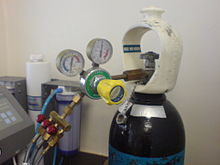
Industrial gases are the
Industrial gases are used in a wide range of industries, which include
Some
Early history of gases
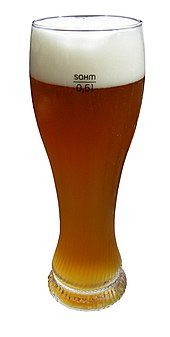

Early understanding consisted of empirical evidence and the protoscience of alchemy; however with the advent of scientific method[6] and the science of chemistry, these gases became positively identified and understood.

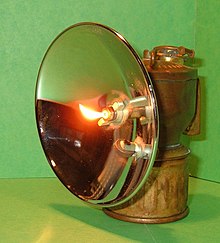
The
Carbon dioxide, hydrogen, nitrous oxide, oxygen, ammonia, chlorine, sulfur dioxide and

Once gases had been discovered and produced in modest quantities, the process of
The development of uses in refrigeration also enabled advances in
Although no one event marks the beginning of the industrial gas industry, many would take it to be the 1880s with the construction of the first high pressure gas cylinders.[20] Initially cylinders were mostly used for carbon dioxide in carbonation or dispensing of beverages. In 1895 refrigeration compression cycles were further developed to enable the liquefaction of air,[25] most notably by Carl von Linde[26] allowing larger quantities of oxygen production and in 1896 the discovery that large quantities of acetylene could be dissolved in acetone and rendered nonexplosive allowed the safe bottling of acetylene.[27]
A particularly important use was the development of welding and metal cutting done with oxygen and acetylene from the early 1900s. As production processes for other gases were developed many more gases came to be sold in cylinders without the need for a gas generator.
Gas production technology

Cryogenic technologies also allow the
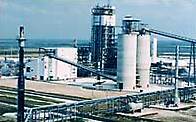
The other principal production
Air Separation and hydrogen reforming technologies are the cornerstone of the industrial gases industry and also form part of the technologies required for many fuel
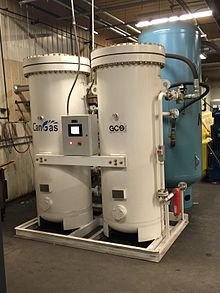
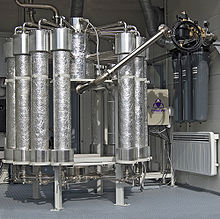
Simpler
In addition to the major gases produced by air separation and syngas reforming, the industry provides many other gases. Some gases are simply byproducts from other industries and others are sometimes bought from other larger chemical producers, refined and repackaged; although a few have their own production processes. Examples are hydrogen chloride produced by burning hydrogen in chlorine, nitrous oxide produced by thermal decomposition of ammonium nitrate when gently heated, electrolysis for the production of fluorine, chlorine and hydrogen, and electrical corona discharge to produce ozone from air or oxygen.
Related services and technology can be supplied such as
.Gas distribution
Mode of gas supply

Most materials that are gaseous at ambient temperature and pressure are supplied as compressed gas. A
However, not all industrial gases are supplied in the
Permanent gases (those with a critical temperature below ambient) can only be supplied as liquid if they are also cooled. All gases can potentially be used as a refrigerant around the temperatures at which they are liquid; for example nitrogen (R728) and methane (R50) are used as refrigerant at cryogenic temperatures.[25]
Exceptionally carbon dioxide can be produced as a cold solid known as dry ice, which sublimes as it warms in ambient conditions, the properties of carbon dioxide are such that it cannot be liquid at a pressure below its triple point of 5.1 bar.[30]
Acetylene is also supplied differently. Since it is so unstable and explosive, this is supplied as a gas dissolved in acetone within a packing mass in a cylinder. Acetylene is also the only other common industrial gas that sublimes at atmospheric pressure.[30]
Gas delivery

The major industrial gases can be produced in bulk and delivered to customers by
Most gases are sold in
Some materials are dangerous to use as a gas; for example, fluorine is highly reactive and industrial chemistry requiring fluorine often uses hydrogen fluoride (or hydrofluoric acid) instead. Another approach to overcoming gas reactivity is to generate the gas as and when required, which is done, for example, with ozone.
The delivery options are therefore local gas generation,
Bulk liquid gases are often transferred to end user storage tanks. Gas cylinders (and liquid gas containing vessels) are often used by end users for their own small scale distribution systems. Toxic or flammable gas cylinders are often stored by end users in gas cabinets for protection from external fire or from any leak.
Gas cylinder color coding

Despite attempts at standardization to facilitate user and first responders' safety, no universal coding exists for cylinders with industrial gases, therefore several color coding standards are in usage. In most developed countries of the world, notably countries of European union and United Kingdom, EN 1089-3 is used, with cylinders of liquefied petroleum gas being an exception.
In United States of America, no official regulation of color coding for gas cylinders exists and none is enforced.[31]
What defines an industrial gas
Industrial gas is a group of materials that are specifically manufactured for use in
The term “industrial gases”
In principle any gas or gas mixture sold by the "industrial gases industry" probably has some industrial use and might be termed an "industrial gas". In practice, "industrial gases" are likely to be a pure compound or a mixture of precise
There are cases when a gas is not usually termed an "industrial gas"; principally where the gas is processed for later use of its
The
The petrochemical industry is also seen as distinct. So petrochemicals (chemicals derived from petroleum) such as ethylene are also generally not described as "industrial gases".
Sometimes the chemical industry is thought of as distinct from industrial gases; so materials such as ammonia and chlorine might be considered "
Small scale gas supply of hand-carried containers is sometimes not considered to be industrial gas as the use is considered personal rather than industrial; and suppliers are not always gas specialists.
These demarcations are based on perceived boundaries of these industries (although in practice there is some overlap), and an exact scientific definition is difficult. To illustrate "overlap" between industries:
Manufactured
Helium is an industrial gas, even though its source is from
Any gas is likely to be considered an industrial gas if it is put in a gas cylinder (except perhaps if it is used as a fuel)
Propane would be considered an industrial gas when used as a refrigerant, but not when used as a refrigerant in LNG production, even though this is an overlapping technology.
Gases
Elemental gases
The known
(Synthetic elements have no relevance to the industrial gas industry; however for scientific completeness, note that it has been suggested, but not scientifically proven, that metallic elements 112 (Copernicium) and 114 (Flerovium) are gases.[35])
The elements which are stable
In the industrial gases industry the term "elemental gases" (or sometimes less accurately "molecular gases") is used to distinguish these gases from molecules that are also
Radon is chemically stable, but it is
Chlorine is the only elemental gas that is technically a vapor since STP is below its critical temperature; whilst bromine and mercury are liquid at STP, and so their vapor exists in equilibrium with their liquid at STP.
Other common industrial gases
This list shows the other most common gases sold by industrial gas companies.[1]
- Compound gases
- ammonia (NH3)
- carbon dioxide (CO2)
- carbon monoxide (CO)
- hydrogen chloride (HCl)
- nitrous oxide (N2O)
- nitrogen trifluoride (NF3)
- sulfur dioxide (SO2)
- sulfur hexafluoride (SF6)
- Hydrocarbon gases
- Significant gas mixtures
- air
- breathing gases
- forming gas
- welding shielding gas
- synthesis gas
- Penning mixture
- Mixed Refrigerant used in LNGcycles
There are many gas mixtures possible.
Important liquefied gases
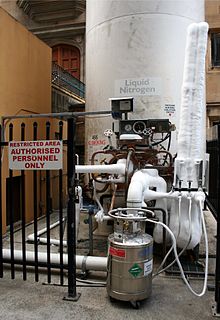
This list shows the most important liquefied gases:[1]
- Produced from air
- liquid nitrogen (LIN)
- liquid oxygen (LOX)
- liquid argon (LAR)
- Produced from various sources
- Produced from hydrocarbon feedstock
- Gas mixtures produced from hydrocarbon feedstock
- Liquefied natural gas(LNG)
- Liquefied petroleum gas (LPG)
Industrial gas applications
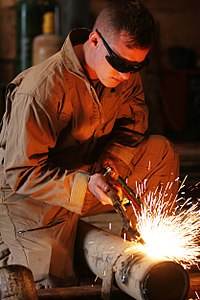
The uses of industrial gases are diverse.
The following is a small list of areas of use:
- aerosol propellants
- Airgun / paintball
- beer widget
- calibration gas
- Coolant
- Cryogenics
- Cryogenic fuel
- Cutting and welding
- Dielectric gas
- Environmental protection
- Fire fighting / gaseous fire suppression
- Food processing[36][37]
- packaging gas
- Gas discharge lamp
- Metrology & measurement
- Laboratory and instrumentation
- Gases for safety and inerting
- Glass, ceramics, other minerals
- Lifting gas
- Medical gas therapy
- Metallurgy
- Propellant
- Refrigerators
- rocket propellant
- plastics, paint
- Semiconductor industry in Semiconductor fabrication plants
- Soda fountain
- Water treatment / Industrial water treatment
- Underwater diving
Companies
- The Linde Group)
- Airgas (part of Air Liquide)
- Air Liquide
- Air Products & Chemicals
- BASF
- The Linde Group)
- Gulf Cryo
- INOX Air Products (part of INOX Group)
- Linde AG)
- Messer Group
- MOX-Linde Gases
- The Linde Group)
- Pro Gases UK
- Nippon Gases (part of Taiyo Nippon Sanso Corporation)
- Taiyo Nippon Sanso Corporation)
- Rotarex
See also
- Air separation
- Chemical engineer
- Cryogenics
- Energy technology
- Gas cabinet
- Gas cylinder
- Gas separation
- Gas to liquids
- History of manufactured gas
- Hydrogen economy
- Hydrogen storage
- Hydrogen technologies
- Liquefaction of gases
- Liquid air
- List of gases
- Natural-gas processing
- Timeline of chemical element discoveries
- Timeline of hydrogen technologies
- Timeline of low-temperature technology
References
- ^ a b c d "EIGA - Our Industry". Retrieved 2016-01-01.
- PMID 15590771.
- ^ "History". NaturalGas.org. 1 Jan 2011. Archived from the original on 2013-11-07.
- ^ "Sulphur Fumigation candle". Retrieved 26 Apr 2018.
- ^ "Practical Winery & Vineyard Journal Jan/Feb 2009". www.practicalwinery.com. 1 Feb 2009. Archived from the original on 2013-09-28.
- ^ Asarnow, Herman (2005-08-08). "Sir Francis Bacon: Empiricism". An Image-Oriented Introduction to Backgrounds for English Renaissance Literature. University of Portland. Archived from the original on 2007-02-01. Retrieved 2007-02-22.
- ^ Cooper, Alan (1999). "Joseph Black". History of Glasgow University Chemistry Department. University of Glasgow Department of Chemistry. Archived from the original on 2006-04-10. Retrieved 2006-02-23.
- ^ a b c d e f g h i "The chemical elements". vanderkrogt.net. Retrieved 2014-07-19.
- . Retrieved 6 November 2007.
- ^ a b "Nitrous Oxide - Laughing Gas". School of Chemistry, University of Bristol. Retrieved 2014-07-19.
- ISBN 9780941901123.
- ^ "Carl Wilhelm Scheele". History of Gas Chemistry. Center for Microscale Gas Chemistry, Creighton University. 2005-09-11. Retrieved 2007-02-23.
- ^ "The History of Ammonia" (PDF). firt.org.
- ^ "Chemistry in its element - methane". Royal Society of Chemistry. Retrieved 28 Jul 2014.
- ^ Carl Wilhelm Scheele, Chemische Abhandlung von der Luft und dem Feuer (Chemical treatise on air and fire) (Upsala, Sweden: Magnus Swederus, 1777), § 97: Die stinckende Schwefel Luft (The stinking sulfur air [i.e., gas]), pp. 149-155.
- ^ "Chemistry in its element - carbon monoxide". Royal Society of Chemistry. Retrieved 28 Jul 2014.
- ^ "Chemistry in its element - hydrochloric acid". Royal Society of Chemistry. Retrieved 28 Jul 2014.
- ^ Miller, S.A. (1965). Acetylene: Its Properties, Manufacture and Uses. Vol. 1. Academic Press Inc.
- ^ "Helium facts - History". www.helium-corp.com. Archived from the original on 2014-11-19. Retrieved 2014-07-05.
- ^ a b c d "Celebrating 100 Years as The Standard for Safety: The Compressed Gas Association, Inc. 1913 – 2013" (PDF). www.cganet.com. 11 September 2013. Archived from the original (PDF) on 26 June 2017. Retrieved 11 September 2013.
- ^ "History - Discovering Chlorine". www.chlorineinstitute.org. Retrieved 2014-07-06.
- ^ "Kipp Gas Generator.Gases on tap". Bruce Mattson, Creighton University. Retrieved 9 Jan 2014.
- ^ "Feed The World" (PDF). Institution of Chemical Engineers. March 2010. Archived from the original (PDF) on 2015-09-24. Retrieved 2014-01-07.
- ^ "SIGNIFICANT EVENTS IN THE HISTORY OF LNG" (PDF). www.energy.ca.gov. 1 March 2005. Archived from the original (PDF) on 6 February 2017. Retrieved 13 September 2013.
- ^ a b "Cool Inventions" (PDF). Institution of Chemical Engineers. September 2010. Archived from the original (PDF) on 2014-01-13. Retrieved 2014-01-07.
- ISBN 9780941901123.
- ^ History – Acetylene dissolved in acetone Archived 2015-09-15 at the Wayback Machine. Aga.com. Retrieved on 2012-11-26.
- ^ "How hydrogen is transforming these tiny Scottish islands".
- ^ [1]. Linde.com. Retrieved on 2015-12-07.
- ^ a b c d "Gas Encyclopedia". Archived from the original on 2014-02-22. Retrieved 2014-02-02.
- ^ "An example of yet another medication error - of sorts! Gas Cylinder Colors ARE NOT an FDA Standard!". Anesthesia Patient Safety Foundation. Retrieved 2024-01-22.
- ^ "BCGA". Retrieved 2013-10-10.
- ^ "Industrial Gases Market (Hydrogen, Nitrogen, Oxygen, Carbon Dioxide, Argon, Helium, Acetylene) - Global and U.S. Industry Analysis, Size, Share, Growth, Trends and Forecast, 2012 - 2018". PR Newswire. July 31, 2013.
- ^ [2]. socratic.org. Retrieved on 2018-08-28.
- ^ Kratz, J. V. (5 September 2011). The Impact of Superheavy Elements on the Chemical and Physical Sciences (PDF). 4th International Conference on the Chemistry and Physics of the Transactinide Elements. Retrieved 27 August 2013.
- ^ "CO2 shortage". BBC News. 27 June 2018. Retrieved 28 Jun 2018.
- ^ "Gasworld CO2 shortage". 27 June 2018. Retrieved 28 Jun 2018.
External links
 Media related to Industrial gases at Wikimedia Commons
Media related to Industrial gases at Wikimedia Commons
